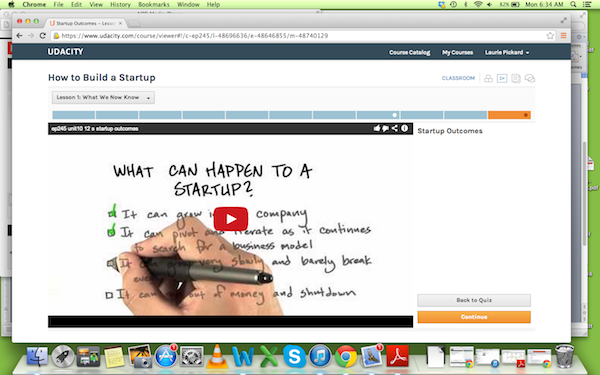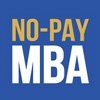by Laurie Pickard | Jan 17, 2014 | Thoughts on Higher Ed and Life
 It’s been an exciting few days, with an article about the No-Pay MBA appearing on Poets and Quants, CNN Money/Fortune, and a host of other websites. I couldn’t be happier about the press coverage. The overall response to my project – in comments on my website and on the articles, and through Facebook and social media shares – has been incredibly positive. I’ve even heard from a few people who have been inspired to start their own MOOC-based educational programs.
It’s been an exciting few days, with an article about the No-Pay MBA appearing on Poets and Quants, CNN Money/Fortune, and a host of other websites. I couldn’t be happier about the press coverage. The overall response to my project – in comments on my website and on the articles, and through Facebook and social media shares – has been incredibly positive. I’ve even heard from a few people who have been inspired to start their own MOOC-based educational programs.
I have also, however, received a few skeptical comments. Several people have asked whether a university will be granting me a degree at the end of all this. (Answer: No.) One even wondered what would be the point of doing all this work if I wasn’t expecting to get a degree out of it.
I’m happy to accept criticism of my project – in fact, it is only by addressing its weaknesses that I can improve it. So thank you to those who have raised these questions. While thinking about the issues readers have raised, I have also been considering the material I am learning in my course on how to build a startup. One of the core components of building a startup is defining its value proposition. It is critical to understand exactly what problem your product is trying to solve, and for whom. Although I don’t have any current plans to turn the No-Pay MBA into a business, I do care about providing a valuable product to my “customers,” i.e. my readers.
I assume that, like me, my customers would like to have an MBA, but aren’t convinced that traditional degree programs are worth the time and money they cost. I created the No-Pay MBA as a solution to that problem – but as my critics have recognized, so far it is only a partial solution. The value of any degree can be broken down into three parts: what you learn, signaling, and connections. Let’s consider how the No-Pay MBA might address each of these.
Skills and knowledge are the foundation
One of my biggest questions before starting this project was whether enough information was out there, freely available, to add up to an MBA, and whether I could absorb that material through the MOOC format. The more MOOCs I complete and the more courses that come online, the more I believe that there is plenty material out there, and that I can in fact absorb it. I won’t have a problem learning as much as or more than I did in my brick-and-mortar graduate program. Especially interesting for me in reading the responses to the Poets and Quants article is that almost no one has questioned my ability to learn B-school material through MOOCs.
Again, I am reminded of my course on startups. The instructor says over and over that the only way to test your hypotheses is to “get out of the building” and speak to your potential customers. When I first started this project, I thought that the primary value of my blog would be to provide readers with a roadmap for combining courses into an MBA so that they too could acquire business skills free of charge. I still do see the roadmap function as being an important part of the blog, but I can see that there are other “pains” (to use the language of the startups course) associated with getting a MOOC-based MBA that I could address.
A school is a brand
While new skills and information are the backbone of an education, they do not comprise its entire value – otherwise there’s no way top B-schools would be able to command upwards of $100,000 for a two-year degree when much of what they teach is available free of charge. Much of the value, and for some people the lion’s share of it, comes from the other two components – the signaling and the network.
What do I mean by signaling? When an employer sees on your resume that you got an MBA from Harvard Business School, he or she assumes you are top-notch. If you got into Harvard, you must be smart, and if you finished, you must have learned something. That is the signal that the Harvard name sends. In other words, a degree-granting institution functions like a brand.
A MOOC can’t provide the first part of the signal, since there isn’t any admissions process. It is, however, possible that some of the prestige of the universities offering MOOCs will rub off on the students who complete them – I certainly hope that is the case. But it remains to be seen whether employers will read completion of a series of MOOCs from prestigious schools as a signal of actual learning.
As I’ve said, I know I’m learning. So how can I bring credibility to the No-Pay MBA? Appearing on CNN Money certainly helps my individual case, but will it help anyone besides me? I do think that a highly publicized example can help other people by raising awareness about the possibilities MOOCs present.
I wonder whether MOOC students would find value in third-party verification – not a stack of Statements of Accomplishment, but a certificate from another provider that attests to your completion of a course of study. For a model of this approach, check out Skills Academy.
The value of a network
Most of the comments I received questioning the value of the No Pay MBA centered on signaling, but I also see a great opportunity for networking among “graduates” of self-designed degree programs. If we can organize ourselves, we could help each other out by sharing information, offering advice, and making real-world connections. I would love to see the No Pay MBA site become a hub for people pursuing MOOC-based MBAs.
If you are attempting a MOOC MBA and can think of other ways this website can help you out, I would love to hear from you.
by Laurie Pickard | Jan 13, 2014 | Courses, Platforms, and Profs

As I’ve mentioned previously, this semester I’m focusing on finance and entrepreneurship. To kick off the entrepreneurship piece, I’m taking a course from Udacity called How to Build a Startup. It is a fantastic course. First of all, Udacity is different from other platforms both in terms of the format and the concept behind it. All of Udacity’s courses are self-paced. In my course, each unit is made up of a series of very short videos – around 2 to 3 minutes. I don’t have much time to do coursework during the work week, but sometimes with this course I tell myself I’ll just watch a couple of videos and then end up finishing a unit because the videos are so quick and engaging.
The other thing I love about Udacity is that all of the courses are focused on acquiring practical skills. Courses are exclusively in the fields of science, technology, math, and business – many are in computer programming. How to Build a Startup avoids all of my pet peeves about MOOCs - the instructor never asksus to post on discussion forums just for the sake of posting, he urges us constantly to get out of the building and test our hypotheses on potential customers, and he goes into detail rather than just skimming the surface of the topics he’s covering.
The backbone of How to Build a Startup is something called the Business Model Canvas. This is a great tool for organizing your thinking around a startup business. The instructor, Steve Blank, who has founded many startups, emphasizes that filling in the spaces on the canvas is an iterative process that must involve talking to potential customers. I’m only three units into the course, but I’ve already started thinking about several business ideas. The most tangible so far relates to my current project, The No Pay MBA. Since starting this course, I’ve been thinking in a new way about the value proposition my blog offers to my readers (a.k.a. my customers). I’d love to see this blog become a sort a community hub for people who are working on their own free MOOC-based MBAs.
Below is a partially filled in first iteration of my business model canvas. You can click on it to see a larger version. I’d love to hear from you about what needs those of you who are contemplating doing a No Pay MBA would like to have addressed, what uncertainties or challenges or annoyances you’ve experienced so far if you’ve already started one.

by Laurie Pickard | Jan 3, 2014 | Thoughts on Higher Ed and Life
 One of the best things about a No-Pay MBA is that you can start one any time. Because new MOOCs are starting pretty much continuously, it isn’t necessary to stick to a semester schedule. Still, it can be helpful to break up the year into chunks, and many new classes are released around when college semesters typically start. So, as we head into spring semester, here are a few tips to help as you choose your courses.
One of the best things about a No-Pay MBA is that you can start one any time. Because new MOOCs are starting pretty much continuously, it isn’t necessary to stick to a semester schedule. Still, it can be helpful to break up the year into chunks, and many new classes are released around when college semesters typically start. So, as we head into spring semester, here are a few tips to help as you choose your courses.
1. Go in with an idea of the topics you’d like to study, but be flexible.
I think it’s a good idea to have an overarching structure to guide you, rather than just taking business courses willy nilly. That said, because it’s hard to predict which courses will be available when, it’s important to remain flexible. For example, I had planned to take a marketing course this semester, but I haven’t found any yet. So instead I’ve chosen to take some advanced courses in finance and entrepreneurship, which I was planning to do the following semester.
2. Choose courses from a variety of sites.
When it comes to business and management courses, Coursera has the best selection by far. But don’t forget about NovoEd, Open2Study, Udacity, and Canvas, all of which have a good selection of business courses as well. Not all of my courses are taught by university professors either. I am working on a Udacity course on entrepreneurship with a teacher who is a phenomenal lecturer with loads of real-world business experience. For my purposes, it doesn’t matter that he isn’t connected with a university.
3. Set up a mail filter.
I highly recommend sending all of your MOOC-related mail to a dedicated folder. If you use Gmail – and who doesn’t these days? – and don’t know how to set up a filter, you can learn how to do it here. As soon as I register for a new MOOC site, I immediately set up a filter to send all mail from that site’s domain name to go to my “MBA” folder. That way, there’s only one place in my inbox to look for all course updates.
4. Do a trial or “shopping” period, then un-register from courses you don’t want to take.
When I was in college, at the beginning of every semester I would register for a dozen classes, attend each of them a couple of times, and then make a final decision about which of them to attend for the entire semester. I recommend a similar strategy for your No-Pay MBA coursework. So far, I am registered for a course in human resources, one on financial markets, one on entrepreneurship, one on financial analysis of entrepreneurial ideas, and one from the HEC School of Management in Paris (in French, I might add) on valuation. If my schedule looks a bit finance-heavy, well it is. I don’t plan to finish all of these courses – I just want to test them out. If you “shop” a bunch of couses before you commit, I think it’s polite to un-register once you’ve decided which ones you’re not interested in finishing. It also cuts down on email clutter.
5. Leave a little room in your schedule for surprises.
Last semester my schedule was so packed I didn’t have time to add any new courses mid-way through. But what if Harvard Business School finally releases it’s long-awaited MOOC series? I want to have some time in my schedule to take a really good course that pops up.
by Laurie Pickard | Dec 28, 2013 | MOOC MBA Design

Crafting your own No-Pay MBA requires a bit more creativity than simply enrolling in an off-the-shelf business program. That said, the process is fun, and it allows for plenty of flexibility – and of course an enormous savings. Here’s how to do it:
1. Ask yourself: What do I hope to achieve by getting an MBA?
Your goal should be realistic and attainable. You will probably want to determine if your needs are better served by getting a traditional MBA. For example, if you want to be a Wall Street investment banker or stock broker, you might need the connections and the cred that come with a traditional MBA. However, if you want to start your own business, advance in your current job, or be eligible for jobs related to your current field that require an understanding of business, a No-Pay MBA could be perfect for you. You can see more of my thinking on this topic here. You might even float the idea to your supervisor by saying something like, “I’m looking into taking business courses. Would it be possible for me to take on some new responsibilities as I acquire new skills?”
2. Ask yourself: Do I have the time to commit to earning an MBA?
This is a very important step. You should budget at least four hours per week per course. If you plan to take two courses at a time (which is what I am doing), then you should expect to spend eight hours each week doing coursework. When I first started my No-Pay MBA I was between jobs, and I loaded up on courses, taking four at once, which was practically a full time job! Now that I’m working, I don’t have time to listen to lectures and do homework during the week, so I block off Saturday mornings to work on my MBA.
3. Make a list of topics you want to cover
I made my checklist by consulting the curriculum pages on the websites of Wharton, Harvard Business School, MIT’s business school, and a couple of others. You could do the same, or you could use the checklist below. I would caution against trying to duplicate my MBA or any other MOOC-based MBA course for course – as per the recommendation in this article, for example – because course availability is not guaranteed from semester to semester. Rather, I would focus on one set of topics during the first year (or first half) and a second set of topics during the second year/second half of your MBA. Check out this post and this page to see how I’ve done my first year.
A general checklist is as follows:
First year
These core courses:
o Accounting
o Corporate Finance
o Marketing
o Management (I would recommend at least two courses in management in the first year. These could include operations management, project management, leadership, small business management, etc.)
Plus three of the following:
o Technology in business
o Microeconomics
o Business ethics
o Organizational psychology
o Human resources management
o Entrepreneurship
o Business innovation
Second year
o Advanced topics in finance, corporate valuation, or accounting
o Business planning
o Business ethics
o Advanced topics in management
o Supply chain management
o Three to four courses related to an area of particular interest (mine is sustainable supply chain management for agri-business)
4. Set ambitious but realistic targets
Now that you have your checklist and you’ve made a commitment to spend time working on your MBA, figure out how many courses you can take each semester and how long it will take you to finish your MBA. Your biggest challenge will be staying motivated, so I suggest holding yourself to a tight timeline. Remember that MOOCs tend to be shorter that regular courses, so you can do more of them in a year. I’m planning to finish my MBA in under 3 years, while working full time.
5. Look at this list and register for courses
As far as I can tell The MOOC List is a complete listing of free courses from all the major MOOC providers. By checking the “business and management” category frequently, you’ll stay up to date on all the free courses that might relate to your No-Pay MBA.
6. Start racking up the SOAs!
Before you know it, you will have a (virtual) pile of Statements of Accomplishment, certificates of completion, and other documentation to show that you are mastering the skills you’ll need in the world of business. As I’ve mentioned previously, I’m still skeptical of Statements of Accomplishment and the like, and I’m not convinced that you should pay anything to receive them. However, I recommend at least keeping a record of the courses you’ve completed and the skills you’ve learned so that you can present them to future employers.
7. Let me know how your No-Pay MBA is going
Okay, this last step isn’t strictly necessary, but I’d love to hear from you. And I’ll make you a deal. If you write to me and tell me that you’re doing a No-Pay MBA, I will post your picture and a short write up about your background, your course of study, and your career goals to my website.
by Laurie Pickard | Dec 20, 2013 | MOOC MBA Design, Thoughts on Higher Ed and Life
By far the biggest challenge when taking an online course is maintaining motivation. With no professor to praise you, no fellow students to foster competition, and – in a MOOC, at least – no credit-granting institution to hold you accountable, you have only your own will power and determination to get you through. Finishing one course – let alone enough courses to add up to a degree - requires a disciplined, intrinsically motivated student.
The numbers tell a similar story. The New York Times recently reported on a University of Pennsylvania study on MOOCs whose headline stats included the fact that fewer than 4% of students finish the courses they register for, and 80% of those enrolled in MOOCs already hold a university degree. These results prompted Forbes to ask if MOOCs are in fact failing in their mission of democratizing education.
To my mind, it’s much too early to label MOOCs a failure. The fact that so many people are interested enough to register for these courses – regardless of whether they finish them – indicates the vast potential of MOOCs. Besides, there are plenty of good reasons why a person might sign up for a course and not finish it. Maybe they were simply curious about the whole MOOC phenomenon and never intended to take a whole course. Maybe they understimated the amount of work involved. Maybe they started the course and then decided the assignments weren’t worth their time. (I’ll be honest, I’ve definitely shirked some assignments in my current MOOC. Don’t even get me started on how much I hate it when 120,000 students are given the assignment of posting a comment on a class-wide discussion forum.)
It all boils down to motivation.
So what might make it easier to sustain the motivation required to finish an online course? Anything that makes the student more socially accountable. Nobody wants to be seen as a slacker or a quitter, but as an anonymous student in an online class it hardly matters if you complete your assignments or not.
My personal solution to the motivation problem is to blog about my courses. Because I’ve made a personal commitment to write about my MBA experience in a public forum, I’m motivated to complete my courses – both to have new material to write about and to make good on what I’ve set out to accomplish.
But any strategy that fosters social accountability could have a similar effect. For example, telling friends and family that you plan to take a course can make it more likely that you’ll finish it. Discussion forums with thousands of students are useless, but a study group – even a virtual one – with just a few students could provide the necessary social accountability. Even better would be a live discussion section with a mentor or facilitator.
For me, the most difficult assignments are those that involve writing or creating something. Problem sets and multiple choice quizzes are easy by comparison. So I’m telling you now, I plan to work harder on creative assignments next semester. You can hold me to that.
 It’s been an exciting few days, with an article about the No-Pay MBA appearing on Poets and Quants, CNN Money/Fortune, and a host of other websites. I couldn’t be happier about the press coverage. The overall response to my project – in comments on my website and on the articles, and through Facebook and social media shares – has been incredibly positive. I’ve even heard from a few people who have been inspired to start their own MOOC-based educational programs.
It’s been an exciting few days, with an article about the No-Pay MBA appearing on Poets and Quants, CNN Money/Fortune, and a host of other websites. I couldn’t be happier about the press coverage. The overall response to my project – in comments on my website and on the articles, and through Facebook and social media shares – has been incredibly positive. I’ve even heard from a few people who have been inspired to start their own MOOC-based educational programs.



 One of the best things about a No-Pay MBA is that you can start one any time. Because new MOOCs are starting pretty much continuously, it isn’t necessary to stick to a semester schedule. Still, it can be helpful to break up the year into chunks, and many new classes are released around when college semesters typically start. So, as we head into spring semester, here are a few tips to help as you choose your courses.
One of the best things about a No-Pay MBA is that you can start one any time. Because new MOOCs are starting pretty much continuously, it isn’t necessary to stick to a semester schedule. Still, it can be helpful to break up the year into chunks, and many new classes are released around when college semesters typically start. So, as we head into spring semester, here are a few tips to help as you choose your courses.

